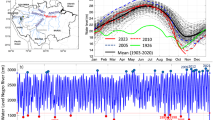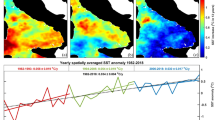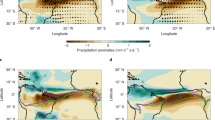Abstract
The long-lasting Sahel drought in the 1970s and 1980s caused enormous human and socio-economic losses1, driving extensive research on its causes2,3,4,5,6,7,8. Although changes in global and regional sea surface temperatures (SSTs) are thought to be dominant drivers of the severe Sahel drying trend9,10,11,12, the mechanisms for the recent recovery trend are not fully clear yet, but are often assumed to be akin to the previous SST–Sahel drought linkage13,14,15. Here we show, by analysing observational and multi-model data and conducting SST-sensitivity experiments with two state-of-the-art atmospheric models, that the SST key area causing the recent Sahel rainfall recovery is the Mediterranean Sea. Anthropogenic warming of this region has driven the shift from the tropical Atlantic and Indo-Pacific oceans, which historically were the main driver of Sahel drought. The wetting impact of Mediterranean Sea warming can become more dominant in a future warming climate and is key to understanding the uncertainty in future Sahel rainfall projections.
This is a preview of subscription content, access via your institution
Access options
Subscribe to this journal
Receive 12 print issues and online access
$209.00 per year
only $17.42 per issue
Buy this article
- Purchase on Springer Link
- Instant access to full article PDF
Prices may be subject to local taxes which are calculated during checkout




Similar content being viewed by others
References
Kandji, S. T., Verchot, L. & Mackensen, J. Climate Change and Variability in the Sahel Region: Impacts and Adaptation Strategies in the Agricultural Sector (United Nations Environmental Programme and World Agroforestry Centre, 2006).
Folland, C. K., Palmer, T. N. & Parker, D. E. Sahel rainfall and worldwide sea temperatures, 1901–85. Nature 320, 602–607 (1986).
Hoerling, M., Hurrell, J., Eischeid, J. & Phillips, A. Detection and attribution of twentieth-century northern and southern African rainfall change. J. Clim. 19, 3989–4008 (2006).
Janicot, S., Moron, V. & Fontaine, B. Sahel droughts and ENSO dynamics. Geophys. Res. Lett. 23, 515–518 (1996).
Martin, E. R. & Thorncroft, C. D. The impact of the AMO on the West African monsoon annual cycle. Q. J. R. Meteorol. Soc. 140, 31–46 (2014).
Cook, K. H. & Vizy, E. K. Coupled model simulations of the west African monsoon system: twentieth- and twenty-first-century simulations. J. Clim. 19, 3681–3703 (2006).
Zeng, N., Neelin, J. D., Lau, K. M. & Tucker, C. J. Enhancement of interdecadal climate variability in the Sahel by vegetation interaction. Science 286, 1537–1540 (1999).
Rotstayn, L. D. & Lohmann, U. Tropical rainfall trends and the indirect aerosol effect. J. Clim. 15, 2103–2116 (2002).
Bader, J. & Latif, M. The impact of decadal-scale Indian Ocean sea surface temperature anomalies on Sahelian rainfall and the North Atlantic Oscillation. Geophys. Res. Lett. 30, 2169 (2003).
Rowell, D. P. The impact of Mediterranean SSTs on the Sahelian rainfall season. J. Clim. 16, 849–862 (2003).
Lu, J. & Delworth, T. L. Oceanic forcing of the late 20th century Sahel drought. Geophys. Res. Lett. 32, L22706 (2005).
Giannini, A., Saravanan, R. & Chang, P. Oceanic forcing of Sahel rainfall on interannual to interdecadal time scales. Science 302, 1027–1030 (2003).
Biasutti, M., Held, I. M., Sobel, A. H. & Giannini, A. SST forcings and Sahel rainfall variability in simulations of the twentieth and twenty-first centuries. J. Clim. 21, 3471–3486 (2008).
Li, H., Wang, H. & Yin, Y. Interdecadal variation of the West African summer monsoon during 1979–2010 and associated variability. Clim. Dynam. 39, 2883–2894 (2012).
Mohino, E., Janicot, S. & Bader, J. Sahel rainfall and decadal to multi-decadal sea surface temperature variability. Clim. Dynam. 37, 419–440 (2011).
Trenberth, K. et al. Climate Change 2007: The Physical Science Basis (IPCC, Cambridge Univ. Press, 2007).
Sutton, R. T. & Hodson, D. L. R. Climate response to basin-scale warming and cooling of the North Atlantic Ocean. J. Clim. 20, 891–907 (2007).
Vizy, E. K. & Cook, K. H. Mechanisms by which Gulf of Guinea and eastern North Atlantic sea surface temperature anomalies can influence African rainfall. J. Clim. 14, 795–821 (2001).
Chiang, J. C. H. & Friedman, A. R. Extratropical cooling, interhemispheric thermal gradients, and tropical climate change. Annu. Rev. Earth Planet. Sci. 40, 383–412 (2012).
Hakkinen, S. & Rhines, P. B. Decline of subpolar North Atlantic circulation during the 1990s. Science 304, 555–559 (2004).
Park, J.-Y., Yeh, S.-W. & Kug, J.-S. Revisited relationship between tropical and North Pacific sea surface temperature variations. Geophys. Res. Lett. 39, L02703 (2012).
Zhang, C. D. Large-scale variability of atmospheric deep convection in relation to sea-surface temperature in the tropics. J. Clim. 6, 1898–1913 (1993).
Dong, B. & Sutton, R. Dominant role of greenhouse-gas forcing in the recovery of Sahel rainfall. Nature Clim. Change 5, 757–760 (2015).
Park, J.-Y., Bader, J. & Matei, D. Northern-hemispheric differential warming is the key to understanding the discrepancies in the projected Sahel rainfall. Nature Commun. 5, 1–8 (2014).
Fontaine, B. et al. Impacts of warm and cold situations in the Mediterranean basins on the West African monsoon: observed connection patterns (1979–2006) and climate simulations. Clim. Dynam. 35, 95–114 (2010).
Gaetani, M., Fontaine, B., Roucou, P. & Baldi, M. Influence of the Mediterranean Sea on the West African monsoon: intraseasonal variability in numerical simulations. J. Geophys. Res. 115, D24115 (2010).
Cook, K. H. & Vizy, E. K. Detection and analysis of an amplified warming of the Sahara Desert. J. Clim. 28, 6560–6580 (2015).
Lavaysse, C. Saharan desert warming. Nature Clim. Change 5, 807–808 (2015).
Schneider, U. et al. GPCC’s new land surface precipitation climatology based on quality-controlled in situ data and its role in quantifying the global water cycle. Theor. Appl. Climatol. 115, 15–40 (2014).
Smith, T. M., Reynolds, R. W., Peterson, T. C. & Lawrimore, J. Improvements to NOAA’s historical merged land-ocean surface temperature analysis (1880–2006). J. Clim. 21, 2283–2296 (2008).
Acknowledgements
We acknowledge the modelling groups and the World Climate Research Programme’s Working Group on Coupled Modelling for their roles in making available the CMIP5 multi-model data set, and the German Climate Computing Center (DKRZ) for providing the computer hardware for our model experiments. This work was supported by the BMBF projects, RACE (FKZ:03F0729D) and MiKlip (FKZ: 01LP1158A), and was carried out in the frame of the internal MPI-M project ‘Tropical VIBES’.
Author information
Authors and Affiliations
Contributions
J.-y.P., J.B. and D.M. contributed to developing the research. J.-y.P. performed the analysis and SST-sensitivity experiments. All authors discussed the results and wrote the paper.
Corresponding author
Ethics declarations
Competing interests
The authors declare no competing financial interests.
Supplementary information
Supplementary Information
Supplementary Information (PDF 4664 kb)
Rights and permissions
About this article
Cite this article
Park, Jy., Bader, J. & Matei, D. Anthropogenic Mediterranean warming essential driver for present and future Sahel rainfall. Nature Clim Change 6, 941–945 (2016). https://doi.org/10.1038/nclimate3065
Received:
Accepted:
Published:
Issue Date:
DOI: https://doi.org/10.1038/nclimate3065
This article is cited by
-
The impact of a uniform ocean warming on the West African monsoon
Climate Dynamics (2024)
-
Near-term regional climate change in East Africa
Climate Dynamics (2023)
-
Changes in Sahel summer rainfall in a global warming climate: contrasting the mid-Pliocene and future regional hydrological cycles
Climate Dynamics (2023)
-
Drivers of low-frequency Sahel precipitation variability: comparing CMIP5 and CMIP6 ensemble means with observations
Climate Dynamics (2023)
-
Uncertainty in the projected changes of Sahel summer rainfall under global warming in CMIP5 and CMIP6 multi-model ensembles
Climate Dynamics (2022)



